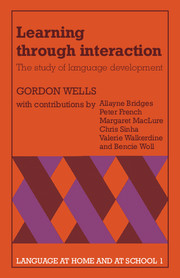Book contents
- Frontmatter
- Contents
- Acknowledgments
- Introduction
- 1 Language as interaction
- 2 Becoming a communicator
- 3 The development of comprehension
- 4 Context, meaning and strategy in parent–child conversation
- 5 Developing linguistic strategies in young school children
- 6 A comparison of talk at home and at school
- 7 Language, literacy and education
- Appendix Bristol language development study: transcripts
- References
- Index
Introduction
Published online by Cambridge University Press: 05 June 2012
- Frontmatter
- Contents
- Acknowledgments
- Introduction
- 1 Language as interaction
- 2 Becoming a communicator
- 3 The development of comprehension
- 4 Context, meaning and strategy in parent–child conversation
- 5 Developing linguistic strategies in young school children
- 6 A comparison of talk at home and at school
- 7 Language, literacy and education
- Appendix Bristol language development study: transcripts
- References
- Index
Summary
It is easy to understand why language has been and continues to be a subject of such widespread interest. From the infant's first interaction with his mother, speech permeates almost all human activity, directing actions, enlarging and modifying knowledge and arousing and communicating emotions. In literate cultures writing adds a further dimension, allowing experience to be recorded in a permanent form and so communicated to others who are removed in time and space. It also provides a means for reflecting upon experience – for working out ideas and feelings away from the pressure of face-to-face communication. Above all, writing is the medium of literature. Through language in its many forms, therefore, we are able to enter into the thoughts, feelings and intentions of others and to discover more about our own.
Although language provides the means for personal development and interpersonal cooperation, its influence is not always so beneficent. Where words can enlighten and unite, they can also be used to conceal and deceive, to spread false information and to stir up hatred and distrust. As well as bringing people closer together, language can also be an instrument of social divisiveness, its various forms and different usages being treated as indicators of relative status and prestige and as a way of controlling access to information and power. In addition to studying language as a universal human phenomenon and its acquisition as an integral part of human development, therefore, it is also necessary to study differences between speakers and between groups of speakers that can contribute to inequality and oppression.
- Type
- Chapter
- Information
- Learning through InteractionThe Study of Language Development, pp. 1 - 21Publisher: Cambridge University PressPrint publication year: 1981



